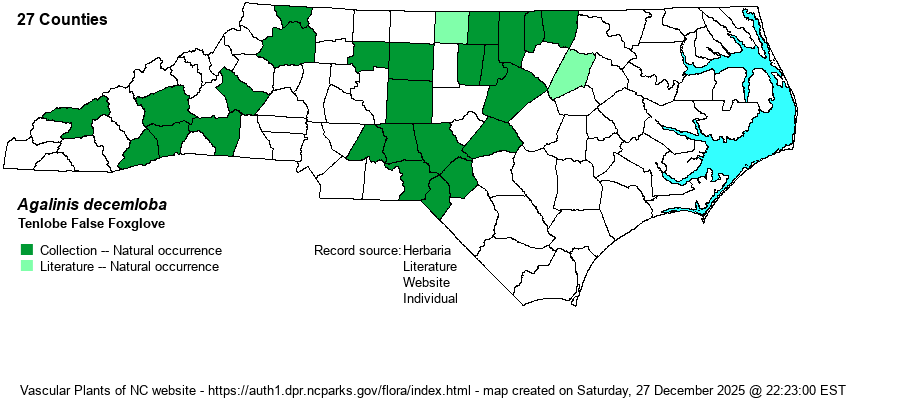| Author | (Greene) Pennell | |
| Distribution | Scattered over the Piedmont and Mountains, with a few large gaps that are not likely real. In the Coastal Plain limited only to the Sandhills. Thus, ranges east to Warren, Nash, Wake, Harnett, and Hoke counties.
This is a species with a fairly small range, centered in the Piedmont and lower Mountain regions. It ranges north to southeastern PA and southern KY, and south only to central AL.
| |
| Abundance | Uncommon in the eastern and central Piedmont, west to Guilford, Randolph, and Stanly counties. Rare in the western Piedmont and lower elevations of the Mountains. Also, rare to uncommon in the Sandhills region. This is a Watch List species, though with records from at least 26 counties, it probably could be dropped from that designation. | |
| Habitat | This species requires bare patches of clay, loamy sand, or on rock slabs, in full sun or partly shaded, of open woodlands, loamy sand areas within Longleaf Pine uplands, woodland borders, roadbanks, powerline clearings, and other places with little competition. It is not a species of deep or xeric sands, as is A. setacea. | |
| Phenology | Blooms in September and October, and fruits from October to November. | |
| Identification | This is a fairly small herb, with quite a few branches, but reaching only about 1-1.5 feet tall. It has opposite but very slender, needle-like leaves, only about 2/5-inch long and 1/10-inch wide at best. At the ends of the many branches are short racemes, often just 1-2 flowers in bloom at a time on a branch, each flower only about 1/2-inch across with five lobes, pink and with two yellow lines in the throat. However, in this species, each of the 5 lobes is slightly indented at the summit of the lobe, and though not really looking like 10 lobes, as the common and scientific names indicate, the five lobes should be noticeably concave in the middle. Not all lobes will show a distinct concavity or notch, but the majority do. There are other Agalinis species that can be confused with it, especially A. obtusifolia, a savanna/flatwood species, that could occur near it. That species has no yellow lines in the throat, has leaves that widen toward the tip and have rounded tips, and stems and branches rough to the touch (as opposed to mostly smooth to the touch). A. setacea, locally common in sandy soils, has a larger and richer rose-colored flower, has some purplish color to the stems, and leaves over 4/5-inch long; the lobes are not notched. The widespread A. purpurea is a much taller and highly branched species with large and bright rose flowers. | |
| Taxonomic Comments | Some references include this species with A. obtusifolia in a single species, not even as varieties. Of course, these lumpers are probably taxonomists that have never seen both species in life; those that have know full well that these are distinct species. Also, some taxonomists consider the ultra rare and federally listed A. acuta from the Northeast to be part of A. decemloba. Data are being gathered by USFWS to determine the relationship between these two.
| |
| Other Common Name(s) | Sandplain Agalinis | |
| State Rank | S3 | |
| Global Rank | G3G4 | |
| State Status | W1 | |
| US Status | | |
| USACE-agcp | | |
| USACE-emp | | |

